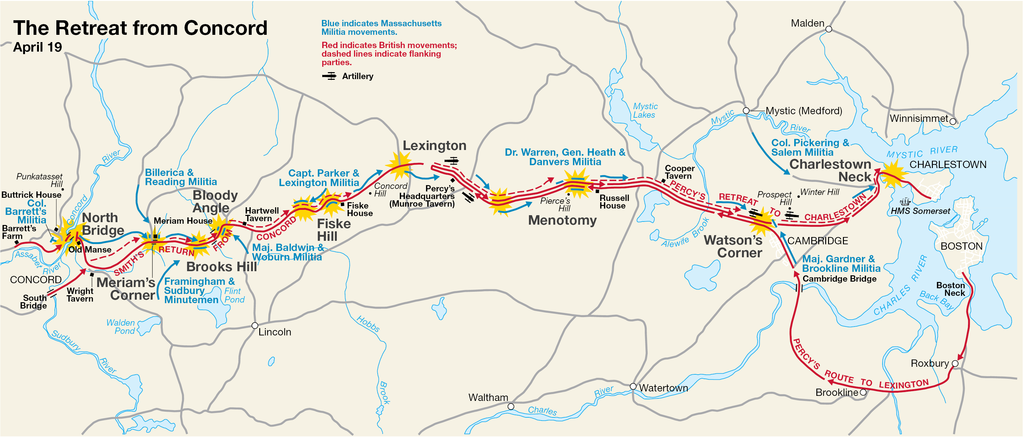April 18 & 19, 1775

Battle Road to Boston
The British forces would not have an easy journey back to Boston. Colonial Militia units were still arriving as news spread of the confrontations in Concord and Lexington. This return went from being an orderly withdrawal, to a retreat, to a desperate rout. The colonists knew the area well, and could more effectively find cover from which to ambush the redcoats.
More units arrived from Reading, Chelmsford, and Billerica. They fired upon the departing troops at Meriam’s Corner. Later on, this 16 mile long skirmish would be referred to as Battle Road, a series of ambushes and later house-to-house fighting from Concord to Charlestown Neck.
Familiar with the land, minutemen were able to fire upon British forces, then retreat further up the road to the next advantageous spot. The first ambush was at Meriam’s Corner, a junction in the roads between Concord and Lexington, where they fired upon British troops from under cover.
Further down the road, other militia groups fired upon the marching redcoats at Brook’s Hill, and then further down the road at Elm Brook Hill. This water crossing was the bloodiest of the ambushes the Colonist militias sprung on British soldiers. Multiple units of Minutemen and militia from surrounding communities converged from multiple directions, able to attack and find cover. The terrain was hilly and wooded, and many stone walls marking land boundaries provided effective cover for the colonists. The skirmish here earned the name Bloody Angle, and is one of the skirmishes along battle road where they have primary source material.
Captain Parker’s Revenge and the Battle Road through Lexington
Captain Parker of Lexington, however, was not done with the British Army. Regrouped, he and his men were able to select a choice spot to exact revenge on retreating British soldiers. There was a narrow bridge on the border of Lexington and Lincoln that the soldiers would need to cross, and there was plenty of coverage from dense woods and large boulders. There Parker’s men ambushed the British soldiers.
...immediately, as we descended the hill into the Road, the Rebels begun a brisk fire, but at so great a distance it was without great effect, but as they kept marching nearer when the Grenadiers found them, they returned their fire just about that time I received a shot through my Right Elbow joint, which effectually (sic) disabled that Arme, it then became a general Firing upon us from all Quarters, from behind hedges and walls we return’d the fire…
There are some interesting archaeological discoveries that give evidence for both British flanking units and the position of Parker’s militiamen at the Friends of Minuteman site https://friendsofminuteman.org/parkers-revenge-battlefield-restoration/
By the time the soldiers reached Lexington, Colonial forces outnumbered British troops. British soldiers holed up at Munroe’s Tavern.
This did not last long, however as the British troops finally met up with reinforcements that had departed from Boston many hours late. This doubled their numbers to nearly sixteen hundred.
The new arriving regiment formed a rearguard, however along the road leaving Lexington, they were fired upon from both behind walls and from within houses along the road. They tried to hold back colonial fire by flanking them and using artillery, however greater Colonial familiarity with the land gave them the home field advantage.
Upon reaching Menotomy (Arlington) militia groups from Watertown, Medford, Malden, Dedham, Needham, Lynn, Beverly, Danvers, Roxbury, Brookline and Menotomy had joined in firing upon retreating British soldiers. Here the fighting became particularly brutal. This region was settled densely enough that the fighting was now house to house, resulting in heavier losses on both sides. Also, they were now in regions more familiar to the British soldiers, so the imbalance of knowledge of terrain began leveling out.
The road from Menotomy eventually led to Alewife Brook in Cambridge – where the fighting continued. One thing that kept the casualties down on the British side was the decision of the British to go through Charlestown, rather than try to cross the bridge in Cambridge – as the colonists were reinforcing the bridge and the battle for it would have taxed already exhausted soldiers.
End of the Road Beginning of a New War
We know (now) look upon ourselves as besieged in Boston, as the Rebels have a Chain of Fortifications all around us, except towards the Sea, which garded (sic) by the Men of War in the Harbour...We are now reduced to live upon Salt pork and peas as fresh provisions are not to be got for Money.
This day was only the beginning of a longer conflict. More than twenty thousand colonists gathered surrounding the city, and thus this event was the beginning of the Siege of Boston. From these gathered volunteers, George Washington would build the first regiments of the Continental Army.


